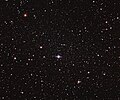Plik:Carina Dwarf Galaxy.jpg

Rozmiar podglądu – 719 × 600 pikseli. Inne rozdzielczości: 288 × 240 pikseli | 576 × 480 pikseli | 921 × 768 pikseli | 1228 × 1024 pikseli | 2456 × 2048 pikseli | 3771 × 3145 pikseli.
Rozmiar pierwotny (3771 × 3145 pikseli, rozmiar pliku: 5,64 MB, typ MIME: image/jpeg)
Historia pliku
Kliknij na datę/czas, aby zobaczyć, jak plik wyglądał w tym czasie.
| Data i czas | Miniatura | Wymiary | Użytkownik | Opis | |
|---|---|---|---|---|---|
| aktualny | 15:14, 24 lut 2015 |  | 3771 × 3145 (5,64 MB) | FDMS4 | Reverted to version as of 14:03, 28 June 2011. |
| 05:00, 24 lut 2015 |  | 3768 × 3144 (5,78 MB) | SteinsplitterBot | Bot: Image rotated by 180° | |
| 16:03, 28 cze 2011 |  | 3771 × 3145 (5,64 MB) | Jmencisom |
Lokalne wykorzystanie pliku
Następujące strony korzystają z tego pliku:
Globalne wykorzystanie pliku
Ten plik jest wykorzystywany także w innych projektach wiki:
- Wykorzystanie na af.wikipedia.org
- Wykorzystanie na ar.wikipedia.org
- Wykorzystanie na ast.wikipedia.org
- Wykorzystanie na ca.wikipedia.org
- Wykorzystanie na de.wikipedia.org
- Wykorzystanie na el.wikipedia.org
- Wykorzystanie na en.wikipedia.org
- Wykorzystanie na es.wikipedia.org
- Wykorzystanie na fi.wikipedia.org
- Wykorzystanie na fr.wikipedia.org
- Wykorzystanie na he.wikipedia.org
- Wykorzystanie na id.wikipedia.org
- Wykorzystanie na it.wikipedia.org
- Wykorzystanie na ja.wikipedia.org
- Wykorzystanie na ko.wikipedia.org
- Wykorzystanie na mk.wikipedia.org
- Wykorzystanie na nl.wikipedia.org
- Wykorzystanie na no.wikipedia.org
- Wykorzystanie na pt.wikipedia.org
- Wykorzystanie na ro.wikipedia.org
- Wykorzystanie na ru.wikipedia.org
- Wykorzystanie na si.wikipedia.org
- Wykorzystanie na sk.wikipedia.org
- Wykorzystanie na tr.wikipedia.org
- Wykorzystanie na uk.wikipedia.org
- Wykorzystanie na vi.wikipedia.org
- Wykorzystanie na www.wikidata.org
